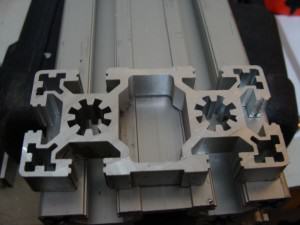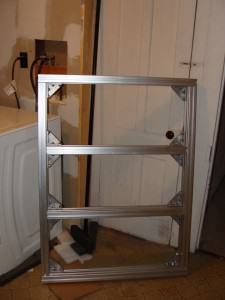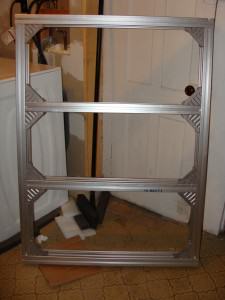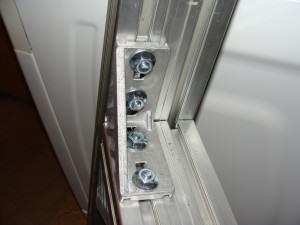The corner braces and gussets have come in for the Bosch-Rexroth aluminum extrusion after waiting a bit. It turns out some bolts I ordered were back-ordered and holding up my whole order. So now that I have some of the pieces I need I can start with the basic assembly. Of course this will all have to come apart once I get the bolts I need to bolt the aluminum extrusions together where the ends meet, but this at least lets me get an idea of how things are going together.
Instead of going with a moving table, I decided to go back to a moving gantry design. There’s a couple of reasons for this, but the largest one is that I can mount the linear rails on the underside of the table to help shield them from cutting debris that could get in the bearings on the carriages and cause them to go bad. If I had gone with a moving table I’d have to design some kind of moving shield to move with the table and protect the rails. While the carriages do have rail scrapers on them, it’s better to restrict the possibility of debris infiltrating into sensitive areas.
Before I could start bolting pieces of aluminum together I needed to cut them to the proper lengths. The pieces I have are almost 46 inches long, and since I decided to switch to a fixed table design with a moving gantry I decided to make the table 45 inches long. The Linear guide’s rails are 41.73 inches long This will leave me with 1.625 inches at the front and back of the linear guides to add mechanical stops and limit switches. The table is going to be 36 inches wide and the cross braces inside of the table are a bit shorter to fit inside the left and right sides.
I used a Diablo D1084L miter saw blade. It’s 10″ diameter with 84 carbide teeth and it cut through this material like butter. I was a bit worried about it at first since I’ve never cut aluminum on a miter saw but it did a great job and the cuts are nice and clean.
Once the pieces were cut I started assembling them together to build the table. I used the 90mmx90mm corner brackets to tie the upper T-rails of all the pieces together. These are held in with 4 T-nuts and bolts each as you can see in the photos below.
While this feels quite sturdy I want to be even stronger. If you look at the end of the 45mm x 90mm extruded aluminum in photo at the top of this page you’ll see that it has two holes with fins through them. These can be used for structural assembly and in some extrusions these are also rated for use as airlines and other things inside of a machine. Once I get my fastening bolts I will be stripping this assembly down and drilling sideways through the outer rails so that I can bolt the shorter cross-wise extrusions with hex head bolts for a string mechanical connection. The angle braces will be used to hold in any adjustments I need to make for alignment and it should be as rock solid as one can get with aluminum extrusion.
End Joining Bosch-Rexroth Aluminum Extrusion
This is a bit of an aside. One of the things I’m going to have to do for additional strength of this platform is tap the horizontal pieces with the 10mm tap and drill holes through the sides of the frames so that everything will be extra strong and secured. I don’t want to rely just on and corner pieces for strength.
Previous: CNC Router Parts and Tools
Next: Drilling and Tapping Aluminum Extrusion
Search CNC Posts





1 responses to Part 4: First DIY CNC Project – Assembling the Frame
Wow nice cutting on the video – I loved watching it and seeing that clean cut.
Leave a reply to Part 4: First DIY CNC Project – Assembling the Frame